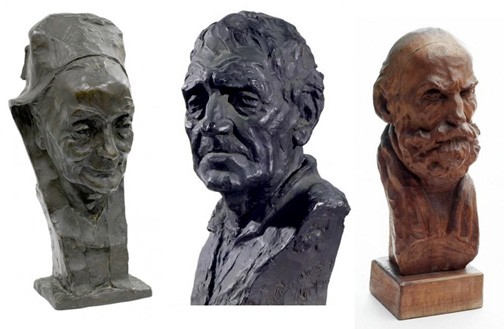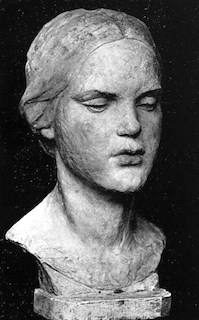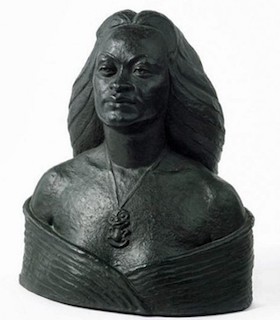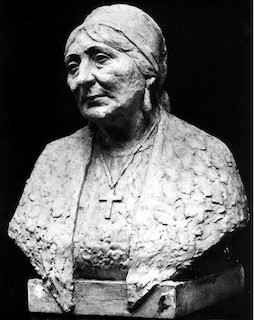Margaret Butler, 1883 – 1947

Born in April 1883 in Greymouth, New Zealand, Margaret Butler moved with her mother and three older siblings to Wellington after her father's death in 1884. In 1923, she traveled to Europe at the age of 40 with her sister Mary. Though the length of time Butler resided at the University Women’s Club is uncertain, she was definitely a resident in 1933.
Initially a watercolor painter, Butler participated in the 1906 –1907 International Exhibition at Christchurch, but sculpture later became her priority. She first trained in Wellington with Joseph Ellis, then in Paris she was a student of Antoine Bourdelle in the early 1920s (Dunn 41) and also painted in Maurice Denis’ Atelier (“Around the Art Galleries”). After Bourdelle's death in 1929, she worked with sculptor Charles-Albert Despiau, whose work she admired for its luminosity (Stocker 2003, 100). Despiau, who admired her skill, is said to have exclaimed, "Mademoiselle, you have the gift of life" (Stocker, 2016).

In 1927, Butler exhibited at the Salon des Beaux-Arts, the Salon des artistes français, and the Salon des Tuileries, showing three works at the latter. Her Parisian sojourn culminated in a solo exhibition at the Galerie Hébrard in July 1933, just a few months before her return to New Zealand in 1934. The exhibition featured 20 of her sculptures and the reviewer in Le Temps praised her as having real talent (Dunn 41).
In Paris, she was a regular at Chez Rosalie, a small Montparnasse restaurant owned by the former model to William Bouguereau and other artists. Butler sculpted and cast a bronze bust of Rosalie in 1926. The bronze is included in the collection of the Museum of New Zealand Te Papa Tongarewa.
Two years earlier, Margaret met her countrywoman, Frances Hodgkins, who had begun teaching at the Académie Colarossi in 1910 and was the first woman to be appointed as an instructor at the school. Butler also came to know the sculptors François Pompon, who lived in Rosalie's building, Léon-Ernest Drivier, Henry Arnold, and Gustinus Ambrosi (Stocker, 2003, 101), all of whom were part of the "Bande à Schnegg, " a group led by sculptor Lucien Schnegg who advocated a return to Hellenic classicism.
When she returned to New Zealand, Butler was celebrated with a solo exhibition at the New Zealand Academy of Fine Arts, but then slowly fell into oblivion (Dunn 43). Nonetheless, she continued to sculpt, and her late works demonstrate her interest in Maori culture. One of her most-acclaimed works from this period is a bronze entitled "La Nouvelle Zélande" (1938), the bust of Miriama Heketa, a performer with the Ngati Poneke Young Maori Club. Butler's friend, poet and journalist Eileen Duggan, wrote numerous articles hailing her as a "gifted sculptress" (Stocker, 2003, 102).

Margaret's sister Mary was her trusted caretaker and social companion for her entire life. Butler suffered from a club foot, and her general health was fragile, which prevented her from sculpting at times and limited the kinds of sculptures she could execute. Despite these health challenges, she managed to enjoy a full social life. As Frances Hodgkins wrote to her mother in 1924, "The Butlers are in the thick of all the Nice festivities – trust the high-spirited Mary for that – they are mighty good sports and don't take life too seriously" (Dunn 41). Margaret was heartbroken when her sister died in 1943. A devout Catholic, she wanted to retire to a convent (Stocker, 2003, 104), but her plan did not come to fruition. Butler died of cancer in 1947.
She bequeathed the contents of her studio to the New Zealand Academy of Fine Arts, which exhibited 28 of her works in 1950 (Stocker, 2003, 105). Her collection was then transferred to the National Art Gallery, a forerunner of the Museum of New Zealand Te Papa Tongarewa (Stocker, 2003, 105).
Sources
- “Around the Art Galleries.” The New York Herald (European Edition), June 16, 1933, p. 9. Gallica.
- Drury, F. M. "Margaret Butler: sculptor." MA thesis, Auckland, 1990.
- Dunn, Michael. New Zealand Sculpture: A History, Auckland University Press, 2002.
- "Exposition visitées." L'art et les artistes, March 1, 1933, p. 354. Gallica.
- Kirker, A. New Zealand women artists. Auckland, 1986.
- “L’exposition de Margaret Butler. Comoedia, June 28, 1933, p. 3. Gallica.
- "Margaret Butler returns." Art in New Zealand, vol. 6, no 3, March 1934, pp. 160-163.
- "Obituary." New Zealand Tablet. December 31, 1947, p. 13.
- Stocker, Mark. "Butler, Margaret Mary," Dictionary of New Zealand Biography, first published in 1998. Te Ara – the Encyclopedia of New Zealand, teara.govt.nz/en/biographies/4b55/butler-margaret-mary.
- Stocker, Mark. Margaret Butler, an invisible sculptor. blog.tepapa.govt.nz/2016/03/14/margaret-butler-an-invisible-sculptor/ 2016.
- Stocker, Mark. "Our local lady Praxiteles: Margaret Butler and her sculpture." Art New Zealand, no. 81, Summer 1996-1997, pp. 74-79, 87.
- Stocker, "Pakeha Praxiteles: The Sculpture of Margaret Butler." Melbourne Art Journal, no. 6, 2003, pp. 93-106.
